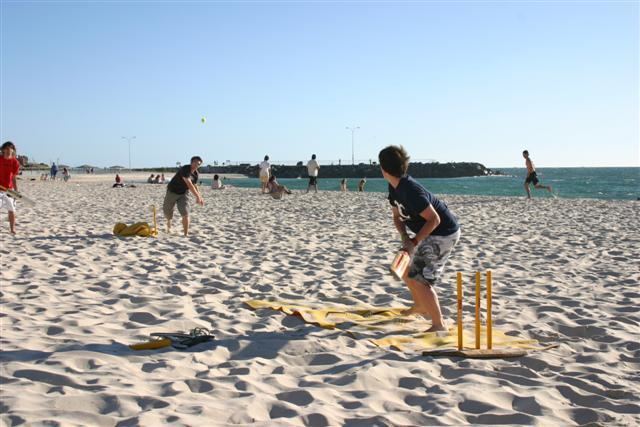 | ||
Backyard cricket, street cricket, beach cricket, gully cricket, corridor cricket, deef or garden cricket is an informal ad hoc variant of the game of cricket, played by people of all genders and all ages in gardens, back yards, on the street, in parks, carparks, beaches and any area not specifically intended for the purpose.
Contents
Backyard cricket has connotations to the past time of Australian children who had large expansive backyards where they were able to play this informal game of sport often with friends, family and neighbours.
Overview
Whilst loosely based upon the game of cricket, many aspects are improvised: the playing ground, the rules, the teams, and the equipment. Quite often there are no teams at all; the players take turns at batting and there is often no emphasis on actually scoring runs. The bat can be anything, as long as it can hit the ball and can be suitably held in the hands. However, usage of a bat is necessary. A ball is the other essential item. Tennis balls are often used due to the fact that they are less likely to inflict injuries than a cricket ball. They are also much cheaper and more readily available than a leather cricket ball and are easier to hit due to their slower air-speed and relative lightness. Tennis balls also bounce more than normal cricket balls, especially at low speeds. Often a tennis ball will be heavily taped on one side to give the ball extra 'swing'. This is known as a 'swing ball'—swing balls may be made with: gaffer tape, electrical tape, plumbing tape or any other kind of tape available. The pitch can be any stretch of ground that is reasonably flat. The wicket may be any convenient object – a chair, a cardboard box, a set of long twigs or sticks, a rubbish bin, tree or a drawing on the wall. Often, the wicket is by no means close to the official size, but it is used anyway. A wicket at the non-striker's end is generally a single stump if proper stumps are available and in the absence of larger objects may be just a hat or a shoe. Its main purpose is to mark the bowler's crease, but can be instrumental when there are two batters and one may be run out.
Garden/backyard cricket in South Africa and Australia is considered by many to be the pinnacle event of social and sporting excellence in the summer period. Many games are paired with a barbecue which often has a carnival atmosphere.
Rules
Backyard cricket allows for rules to be changed, and the rules being played by will depend on the context and physical environment of the game. However a list of the typical rules which are used most of the time are as follows:
Beach cricket
Play on an actual beach can be achieved either by using the flat strip of hard-packed sand along the surf line as the pitch, or by only "bowling" gentle full tosses to avoid the problem of the ball not bouncing off loose sand. If there are no true stumps available a bin, deckchair, boogie board or cool box may be used.
In beach cricket the creases and the boundary are normally drawn in the sand in a line which extends well past the side of the agreed pitch to prevent them becoming obliterated in the first over. The batsmen will frequently redraw the line. Sometimes, play is shifted along the beach to a new pitch as the packed sand of the original pitch is turned up, thus reducing the standard of or even completely disabling bowling.
The tide plays a big part in the standard of the pitch in beach cricket. During low tide, the pitch tends to be on the semi-wet sand, and is deemed superior than cricket played in high tide (when the pitch is on dryer, looser sand). In particularly long matches, the play will shift up and down the beach depending on the tide.
In Brazil
In Brazil, the game is called "taco"(cue) or "bets" and is very practiced by young people on the beaches, in the streets and in schools. Its rules are very similar including the traditional cricket. There are several versions about the origin of the "taco". One is that the game was created by fishermen in Brazil during the eighteenth century; another is that it was practiced by the British Company of the Indies, who played club in the ship's hold during the latch trip of the oceans. To this tradition, the game is a descendant of "cricket"
In the Dominican Republic
In the Dominican Republic exists "la Plaquita" ('The little Plate') or "la Placa" ('The Plate'), a street variation played between two couples, usually making use of broomsticks as bats, rubber or tennis balls, and old license plates as wickets (with their ends twisted to make them stand up). The game is divided in alternate 3-out innings like in baseball. The first team to reach 100 or 200 runs wins.
